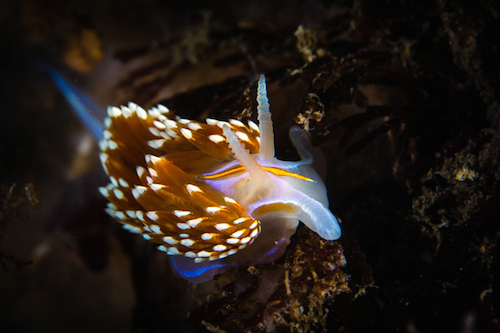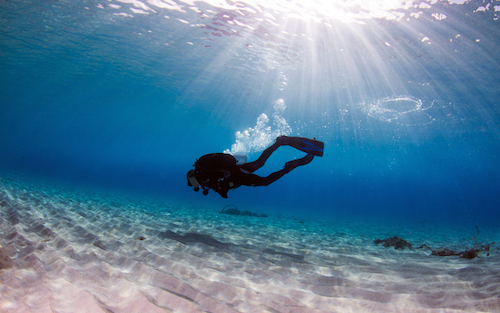Most people don’t even know what a nudibranch is.
When most people think of scuba diving, they imagine a sweeping reefscape that is teeming with beautiful aquarium fish and majestic large animals like dolphins and sea turtles.
The mindset of the diver is no exception, and many divers, particularly those who are new to the sport, kick powerfully around the reef in an effort to cover as much ground as possible.
But every so often, something clicks in the diver’s mind, and she stops in her tracks to inspect something crawling on the reef.
A closer look reveals a nudibranch, a type of sea slug that is completely unlike any slug you might see on land.
Nudibranches are magnificent and gaudy creatures spanning every color of the rainbow, but despite their vibrant coloring, they are often overlooked due to their tiny size.
We can learn a lot from the diver who stops to appreciate the nudibranch:
1. Slow Down.
When we slow down, we notice—and appreciate—more.
We never know what we might find when we start exercising mindfulness in our daily life. Experiment with being truly present in whatever you’re doing.
Sometimes, happiness is in the details. Sometimes those details are tiny and spectacular creatures!
2. Practice finesse.
Transitioning from powerful, ground-covering fin kicks to subtler, more specific movements activates the small muscles in the body and helps us to develop precise control.
Like a good adjustment in yoga class expands our experience of a pose, this newfound command over our trajectories can make all the difference in our ability to move through the ocean—and life—with mindfulness and stability.
3. Make the most of your breath.
In diving, breathing control is of paramount importance.
Losing the breath underwater can result in injury or running out of air prematurely. In addition, our lungs act as balloons and help to fine-tune our buoyancy underwater.
Want to drop a little closer to better inspect that nudibranch? Exhale slightly, and you will sink slightly.
Are you too close to the reef and fear damaging it with your fin kicks? A small inhalation will help your body float.
With practiced conscious breathing, you can carry that buoyancy onto dry land as well.
I see a common progression when I’m supervising new divers. At first, they dash around the reef, seeing nothing—and they breathe their air tanks empty in 20 minutes.
Over time, as they develop comfort in the water and control over their movements and breath, their air consumption decreases.
It’s the nudibranch enthusiasts, though—the divers who love to look for those often-forgotten tiny sea creatures—who make that same tank of air last for 60 minutes or more.
Mindfulness is all about making life last. So enjoy the little things. Breathe deeply. Move slowly and with purpose.
Stop to look for the nudibranchs, and a whole new world will open up for you.
Love elephant and want to go steady?
Sign up for our (curated) daily and weekly newsletters!
~
~
Apprentice Editor: Brandie Smith/Editor: Travis May
Photo: Author’s Own












Read 2 comments and reply